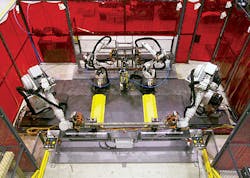Making Flexibility Automatic (sidebar)
Axis Products Inc., an Elkhart, Ind.-based maker of trailer axle assemblies, not only builds products that use more than 5,000 different combinations of components, but it also serves customers ranging from individual trailer owners to Fortune 500 companies.
“We’ve got guys that order one piece. We’ve got guys that order 50,000,” says Axis Products President Eric Overbey. What’s more, the company offers a product line that Overbey describes as “infinitely variable”—axle tube lengths can range from 20 inches to 12 feet long, for example.
For several years, Axis had relied on custom, semi-automated welding machine technology. Throughput for each of three machines was about 30 assemblies per hour. But each machine required four people to operate and the changeover setup time between different product orders ranged from 10 to 20 minutes. With changeovers occurring 10 to 15 times per day, “we were spending a lot of time in set up,” Overbey observes.
By early 2003, the company faced a decision. Heavy demand for its products was outrunning capacity. The choices included acquiring another semi-automated machine and hiring four more operators, or “starting with a blank piece of paper,” says Overbey, to develop a highly flexible, automated system. The company chose the latter approach. After discussing its requirements with multiple vendors, Axis Products settled on Motoman Inc., West Carrollton, Ohio, to provide the system, which was delivered in July 2004.
In all, the system incorporates four Motoman robots—two UP130 material handling robots and two UP6 welding robots, all controlled with a single, Motoman XRC 2001 controller, and programmed with a single teach pendant. The new system reduces set-up times to less than a minute, notes Overbey, and requires only a single operator.
When an order comes in, the operator enters the product criteria using a MotoHMI touch screen human-machine interface, loads the necessary parts in nests beside the machine and hits a green button. “On the very first piece, there’s a laser system that measures the component to within a few thousandths, and if it’s not within tolerance, it tells the operator, so we don’t add value to anything that isn’t right,” Overbey notes.
If the parts are correct, the handling robots pick the required components, move them to the weld station, and rotate the parts 360 degrees while the welding robots perform orbital welds on the tubing. During this process, an automated system verifies the weld quality 100 times per second, says Overbey. If there is a problem with any weld, the system notifies the operator, and destroys the matching components by placing weld beads so that they can’t be assembled.
Once the orbital weld is complete, the assembly is locked into a secondary vice, where the remaining components are tack-welded in place. Then, as the welding robots finish work on the part, the handling robots move back to the loading nest to pick parts for the next assembly.
One key feature of the Motoman-provided system is its flexible fixtures, which incorporate adjustable slides. With Axis Products’ semi-automated machines, a part changeover requires the operators to physically replace one set of part holding fixtures with another. But with the new system, once a new part number is entered, “the machine actually sets itself up,” says Overbey. “We tell the machine what we want to produce and the material handling robots modify all of the loading stations,” he explains.
Besides the resultant dramatic reduction in changeover times, additional benefits of the new system include improved quality, reduced scrap and a 15 percent improvement in cycle time, says Overbey. “Based on our return-on-investment calculations, we think we’ll be able to pay for this system in less than two years.”
See the story that goes with this sidebar: Make Mine Flexible

